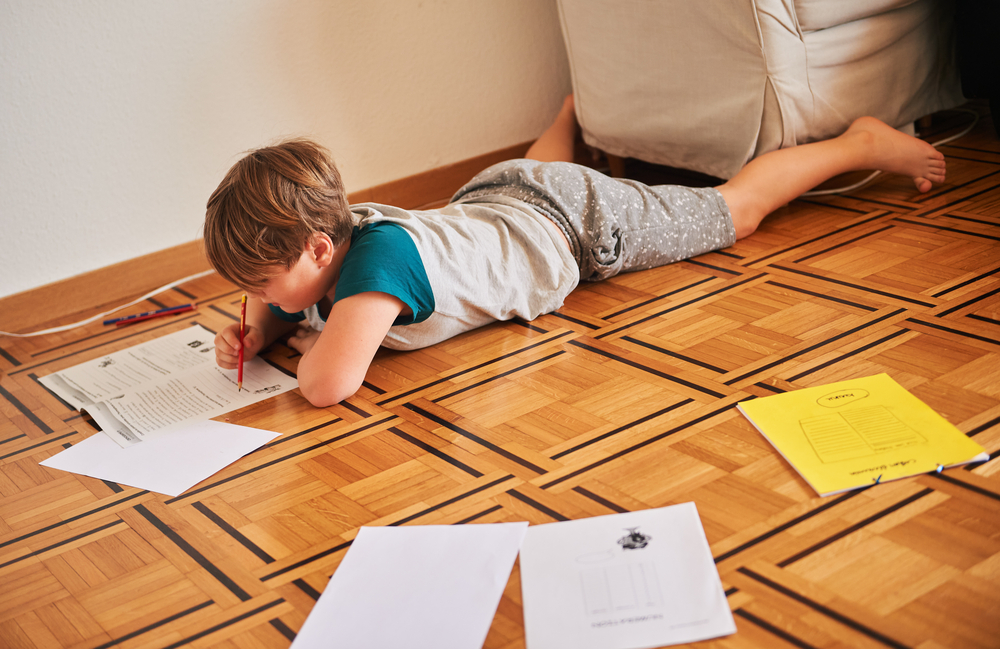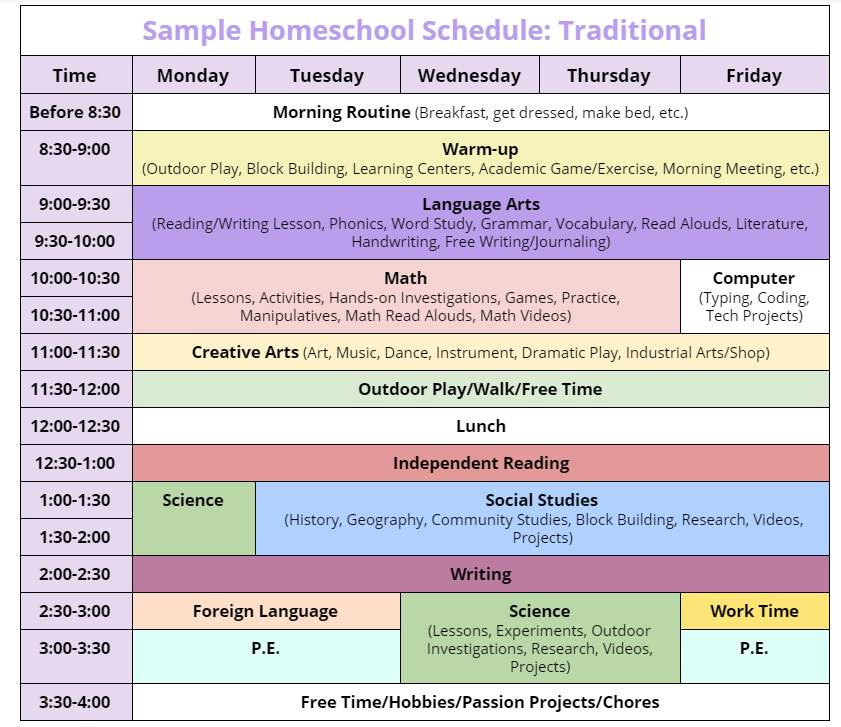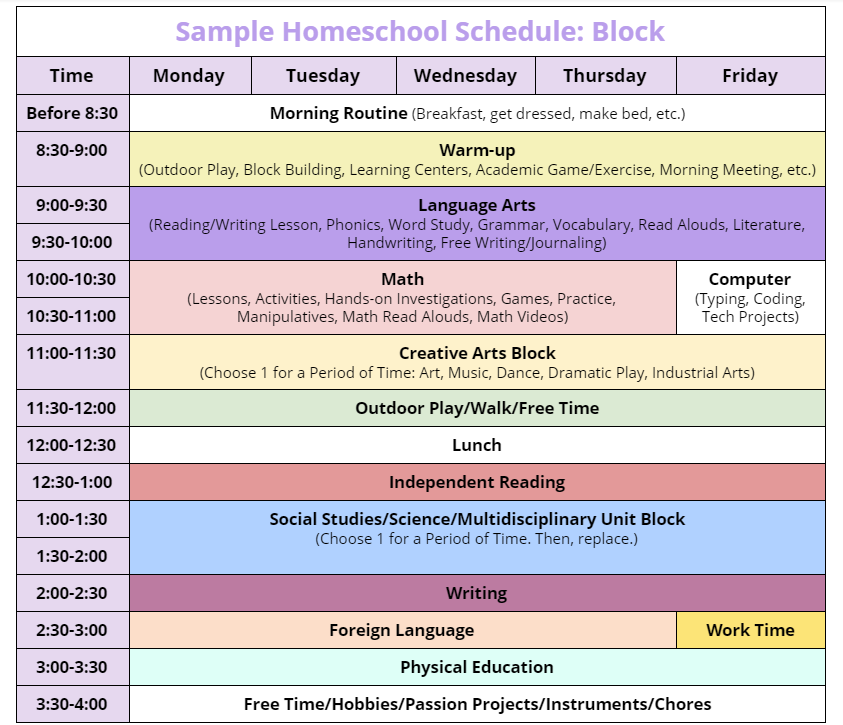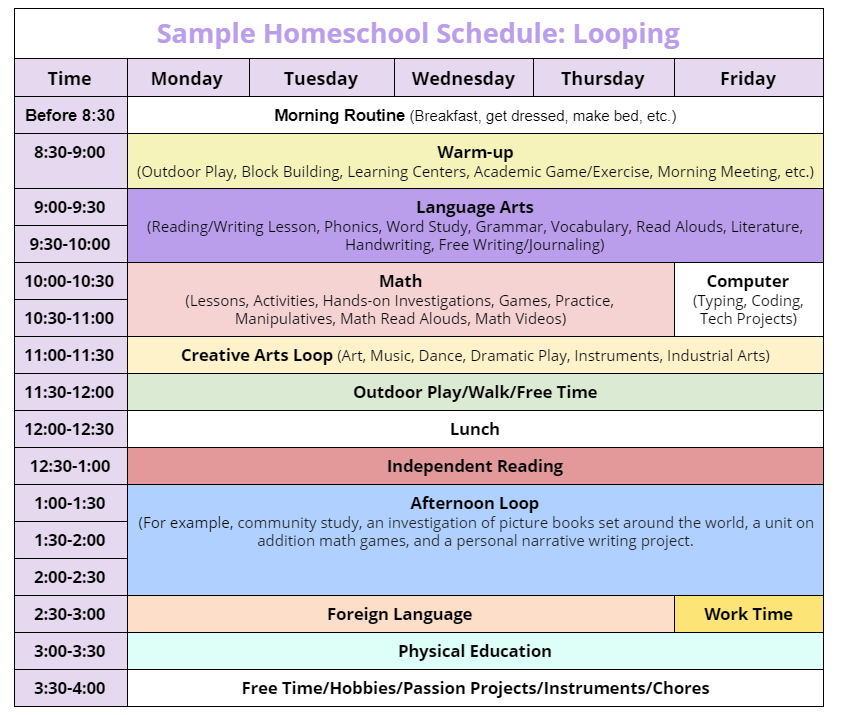Whether you’re new to homeschooling or have a few years experience, one of your first steps to set up your day should be to create a homeschool daily schedule.
As an elementary teacher, I waste not a single moment to establish classroom schedules, routines, and a daily rhythm from the very first day of school. The same holds for students I work with in-home or tutoring.
Some of these systems I plan ahead of time. Others are discussed and agreed upon as a class in the first few days of school so everyone feels the pride of ownership from having built a smooth and flowing classroom environment.

Benefits of a Homeschooling Daily Schedule
Having a daily schedule for homeschool with the routines mapped out is the difference between chaotic, unproductivity and effective teaching and rewarding learning experiences for everyone.
Children thrive on routines. Having an understanding of what the day will be like and what’s expected of them means kids don’t have to spend valuable mental energy anticipating what’s next or how to feel successful.
Daily routines also help children become more independent. Since they know what’s next or how to do a particular task, there’s no need to ask an adult. This is true even with the youngest of students who inevitably feel empowered and successful in their learning environments.
Not only is independence important at every age (with appropriate tasks and activities), it’s a lifesaver for busy families who are trying to juggle working from home, children of different ages, meals, extracurricular family fun, and household work!
What is an Effective Homeschool Schedule?

The great thing is it’s not a one-size-fits-all. I’ve put together some sample homeschool schedules below but ultimately it will depend on what’s best for your family and your educational goals.
With this, however, there are some important tips to keep in mind as you establish your school routine at home.
Some activities may not require as much time as they do in a classroom setting.
The reality is it’s easier to accomplish assignments and activities with a few kids versus a class of 20 or 25. Consider how longer periods of time, though, can be spent going deeper into a subject area.
Structure a full school day.
The average school has 6.5 hour days, 5 days a week, for 180 days a year. Remember, what happens during these hours doesn’t need to look like an exact copy of a regular school day. It also shouldn’t be 6.5 hours of instruction. But setting a framework of hours each day prioritizes learning and personal and family pursuits aside from free time.
Don’t overschedule.
I know, it seems like a contradiction!
But, it’s best to have a few daily goals in mind regardless of whether you choose a homeschool schedule with defined 30-45-minute, subject-specific lessons that repeat throughout the week or extended blocks of time for open-ended unit studies.
Pushing to get too much done in individual subjects on a daily basis is stressful for everyone. There will never be enough time in the day, trust me!
Not to mention, a jam-packed day leaves no time for independent exploration or passion projects.

Keep a flexible mindset to allow for changes.
Life happens. A homeschool day is upended because the power went out or someone is sick. Or maybe a project or unit is so much fun, no one wants to stop. A child’s question leads to a discussion that leads to exploration that changes the day’s schedule. These golden moments should NOT be restricted because of a schedule.
While you do want to establish and protect a homeschool schedule, adapting and pivoting are essential for reducing stress and deepening interest and engagement.
Establishing a routine takes time.
Whatever homeschooling schedule you decide to go with, know that it can take weeks and even a month (or more!) to get to a place where everyone understands and knows what they should be doing at any given time.
The same goes for any routines involving transitions, using and cleaning up materials, and independent work time to allow you one-on-one time with individual children.
Do what’s best for your family/child/children.
The beauty of homeschooling is you can make adjustments to suit your daily life. Have a child who needs physical activity first thing in the morning, who functions better after a meal or snack, or who needs some post-noon quiet time?
It’s not only ok to build your homeschool day around these unique family needs and preferences, but it also increases everyone’s happiness and ability to succeed!
Which Type of Homeschool Daily Schedule is Best?

There are different schools of thought on the best way to schedule out your homeschool day. What’s best depends on your students’ needs and your goals.
Traditional School Schedule
Traditional school schedules plan specific subjects on certain days of the week. For example, Monday-Wednesday-Friday from 9:30-10:30 is writing. On Tuesdays and Thursdays, 9:30-10:30 is Science.
This type of schedule can feel too regimented for some, while others will love its predictability. If students are really into a particular topic or study or benefit from daily consistency, it can be a letdown or even a disruption to skip days before returning to the subject again. On the other hand, some children will thrive on variation and a day with energetic pacing.
Traditional schedules allow you to calculate the number of hours you’re devoting weekly to each subject. It also means you’re managing many subjects daily and weekly. You also have to be mindful of times during the day or week that may be continually getting interrupted for one reason or another and adjust the schedule accordingly.
Block Schedule
A homeschool block schedule is another approach. This means you’re scheduling a particular subject, unit, or study to happen over a period of time (a few weeks, a month, a semester) 4-5 times a week. When this comes to an end, a new subject, unit, or study replaces it.
This allows for continuous flow through the material. You could plan deeper investigations into an area versus concise lesson bites like with a traditional schedule. It also means you’re not managing every subject all the time.
There are a few things to consider with block scheduling. If you’re working with younger students, block scheduling is best for things like social studies, science units, author investigations, art, and music studies. Reading, writing, and math should still happen (near) daily for practice and reinforcement.
For those of you doing multi-disciplinary units or studies with middle and high school-aged students, block scheduling can be a great approach. Knowing these studies cover a lot of academic areas means subjects are blended for sustained chunks of time and deep-dives into content area.
Looping Schedule
Loop scheduling offers a (perhaps less stressful?) variation of a traditional daily homeschool schedule. The premise is you create a list of subjects or activities you want to complete during a set time (1 week, 2 weeks, etc). From there, you progress through each one, looping as many times as you’re able, in that period of time.
So for example, let’s say you and your students were working on a community study, an investigation of picture books set around the world, a unit on addition math games, and a personal narrative writing project.
Rather than assign each activity a set day of the week or only cover 1 or 2 of them in a block schedule, you could use a 2 week-cycle to loop through each one using the minutes or hours you needed for each on a given day.
You’re also not set to a particular period or chunk of time to work on each one. For example, one day the unit on addition math games may go for 45 minutes to introduce new math manipulatives and practice 2 new games. While the next time, there are just 15 minutes to play 1 game that’s already been learned.
Or one afternoon, more than an hour is spent outside making sketches of local businesses as part of the community study. But the next time, only 25 minutes is dedicated for everyone to read a picture book specifically about the community worker that relates to the local business they’re studying.
The great thing about having fluid chunks of work time is you can be responsive to what your students need. Everything going well or nearly completed with the math games unit? Or do students need more time for their personal narrative writing? Adjust the time needed as you see fit.
Sample Homeschool Schedules
I’ve put together some sample homeschooling schedules. Remember, you 100% should adjust these homeschool schedule ideas based on your family, your students, your daily life.
There isn’t a one-size-fits-all approach for the perfect homeschool day schedule. Nor is there just one road to success. And many times, homeschoolers realize a blend of the below schedule options is what ends up being best for them.
Lastly, I haven’t specified the schedules below for a particular age group. That’s because the homeschool schedule templates below can really be modified no matter what age learners you’re homeschooling. I’ve included some examples of content areas to give you a sense of how this would look different depending on the ages and grade-levels of your students.

The first thing you might notice is the hour-long chunks of Language Arts, Math, Science, and Social Studies. Don’t panic!
The hour allows for flexibility. You could break it up into 30-minute chunks for different areas like reading instruction and word study or, for older students, literature and vocabulary. Or you could use the whole time for a specific activity or lesson.
The longer chunks of time also allow you one-on-one time with learners while others are completing work. It’s also possible to take short breaks in between subjects for things like snacks, stretching, or quick playtime with a beloved pet.
This schedule shows how each subject can be managed on a weekly basis in a structured way, while still allowing for flexibility and a less stressful pace to the overall day. It can also be easily adjusted depending on the age of the students.
On all of the schedules, daily independent reading gets its own time slot every day. Whether your child is beginning to read chapter books or is reading works of literature, sustained independent reading is a daily must-do! And it should be separate from reading mini-lessons.
Also, in case you’re wondering about that Friday afternoon “Work Time” on the schedule examples, I like to have time on Fridays to wrap up loose ends, have students complete/correct finished work, or go over something with an individual student who needs some support. You’ll have to decide if this makes sense for you but it’s always nice to start off a new week fresh.

With this modified block-style schedule, you can easily include subjects like language arts and math (nearly) every day. Then, plan creative arts and academic blocks for subjects, topics, and units you want to cover.
It also lends itself to more consistency. You don’t have to wait days before returning to a project or study. It can be something you and your students are immersed in until you’re finished.
Imagine a community study with elementary learners that involves a trip out to visit local businesses, researching the role of that community worker, and then building with blocks to show what they’ve learned about the community.
I like having writing time before, after, or in between science and social studies. These subjects and the projects and activities you plan can include writing which can be a smooth way to transition from one period of time to the next. Students who are researching and need adult help can have it, while others who are ready to begin writing about their research can get started.
Writing can also be its own subject too, depending on what you’re working on at any given time.

I’ve adjusted the previous schedule to show how looping might work while still having language arts and math daily. You could use looping to focus on one creative art at a time, as well as one subject or unit of study during the afternoon block.
With middle or high school learners, the language arts and math periods could also loop through literature studies, writing units, or math life skill units on budgeting and bank accounts.
Ultimately, you’ll have to decide which kind of homeschool schedules and routines are right for you. These can easily be modified for different ages. The day can be shortened, more time given to a specific subject, or you can choose to move subjects so that the day doesn’t start with the same subject all the time.
Put the framework that feels best in place and flexibly adjust it as needed to find the most productive, comfortable flow for your homeschool!
What questions do you have about your homeschool schedule?
Like this post? Please save it for later on Pinterest or share it.

Leave a Reply